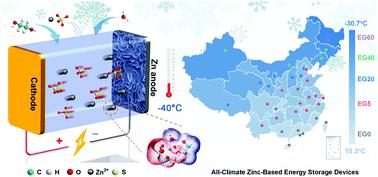当前位置:
X-MOL 学术
›
Energy Environ. Sci.
›
论文详情
Our official English website, www.x-mol.net, welcomes your
feedback! (Note: you will need to create a separate account there.)
An aqueous hybrid electrolyte for low-temperature zinc-based energy storage devices
Energy & Environmental Science ( IF 32.4 ) Pub Date : 2020-08-12 , DOI: 10.1039/d0ee01538e Nana Chang 1, 2, 3, 4, 5 , Tianyu Li 1, 2, 3, 4, 5 , Rui Li 1, 2, 3, 4, 5 , Shengnan Wang 1, 2, 3, 4, 5 , Yanbin Yin 1, 2, 3, 4, 5 , Huamin Zhang 1, 2, 3, 4, 5 , Xianfeng Li 1, 2, 3, 4, 5
Energy & Environmental Science ( IF 32.4 ) Pub Date : 2020-08-12 , DOI: 10.1039/d0ee01538e Nana Chang 1, 2, 3, 4, 5 , Tianyu Li 1, 2, 3, 4, 5 , Rui Li 1, 2, 3, 4, 5 , Shengnan Wang 1, 2, 3, 4, 5 , Yanbin Yin 1, 2, 3, 4, 5 , Huamin Zhang 1, 2, 3, 4, 5 , Xianfeng Li 1, 2, 3, 4, 5
Affiliation

|
Aqueous zinc-based energy storage (ZES) devices are promising candidates for portable and grid-scale applications owing to their intrinsically high safety, low cost, and high theoretical energy density. However, the conventional aqueous electrolytes are not capable of working at low temperature. Here we report a frigostable, cost-effective, safe and eco-friendly hybrid electrolyte with high zinc-ion conductivity (6.9 mS cm−1 at −40 °C), and high reversibility of Zn plating/stripping, which consists of water, ethylene glycol (EG) and zinc sulfate salt (ZnSO4). Experiments together with theoretical calculations demonstrated that the unique solvation interaction of Zn2+ with EG can effectively enhance the hydrogen bonding between EG and H2O and weaken the solvation interaction of Zn2+ with H2O, thus providing the hybrid electrolyte with a lower freezing point and reversible Zn/Zn2+ chemistry. As a proof-of-concept, both Zn-ion hybrid supercapacitors (ZHSCs) and Zn-ion batteries (ZIBs) with the hybrid electrolytes delivered high energy densities (36 W h kg−1 for the ZHSC and 121 W h kg−1 for the ZIB), high power densities (3.1 kW kg−1 for the ZHSC and 1.7 kW kg−1 for the ZIB) and long-cycle life (5500 cycles over 110 days for the ZHSC and 250 cycles for the ZIB) at −20 °C. This work provides a new option for low-temperature energy storage devices.
中文翻译:

用于低温锌基储能装置的水性混合电解质
水性锌基能量存储(ZES)设备本质上具有高安全性,低成本和高理论能量密度,因此是便携式和网格规模应用的有希望的候选者。然而,常规的水性电解质不能在低温下工作。在这里,我们报道了一种易碎,经济,安全,环保的混合电解质,具有高锌离子传导性(在-40°C时为6.9 mS cm -1),并且由水组成的Zn镀层/剥离层具有高可逆性,乙二醇(EG)和硫酸锌盐(ZnSO 4)。实验和理论计算表明,Zn 2+与EG的独特溶剂化作用可有效增强EG与H 2之间的氢键O并削弱Zn 2+与H 2 O的溶剂化作用,从而为混合电解质提供较低的凝固点和可逆的Zn / Zn 2+化学性质。作为概念验证,具有混合电解质的Zn离子混合超级电容器(ZHSC)和Zn离子电池(ZIB)均提供了高能量密度(ZHSC为36 W h kg -1和121 W h kg -1对于ZIB),高功率密度(ZHSC为3.1 kW kg -1和ZIB为1.7 kW kg -1)和长寿命(ZHSC的110天为5500循环,ZIB为250循环)- 20°C。这项工作为低温储能设备提供了新的选择。
更新日期:2020-10-14
中文翻译:

用于低温锌基储能装置的水性混合电解质
水性锌基能量存储(ZES)设备本质上具有高安全性,低成本和高理论能量密度,因此是便携式和网格规模应用的有希望的候选者。然而,常规的水性电解质不能在低温下工作。在这里,我们报道了一种易碎,经济,安全,环保的混合电解质,具有高锌离子传导性(在-40°C时为6.9 mS cm -1),并且由水组成的Zn镀层/剥离层具有高可逆性,乙二醇(EG)和硫酸锌盐(ZnSO 4)。实验和理论计算表明,Zn 2+与EG的独特溶剂化作用可有效增强EG与H 2之间的氢键O并削弱Zn 2+与H 2 O的溶剂化作用,从而为混合电解质提供较低的凝固点和可逆的Zn / Zn 2+化学性质。作为概念验证,具有混合电解质的Zn离子混合超级电容器(ZHSC)和Zn离子电池(ZIB)均提供了高能量密度(ZHSC为36 W h kg -1和121 W h kg -1对于ZIB),高功率密度(ZHSC为3.1 kW kg -1和ZIB为1.7 kW kg -1)和长寿命(ZHSC的110天为5500循环,ZIB为250循环)- 20°C。这项工作为低温储能设备提供了新的选择。











































 京公网安备 11010802027423号
京公网安备 11010802027423号